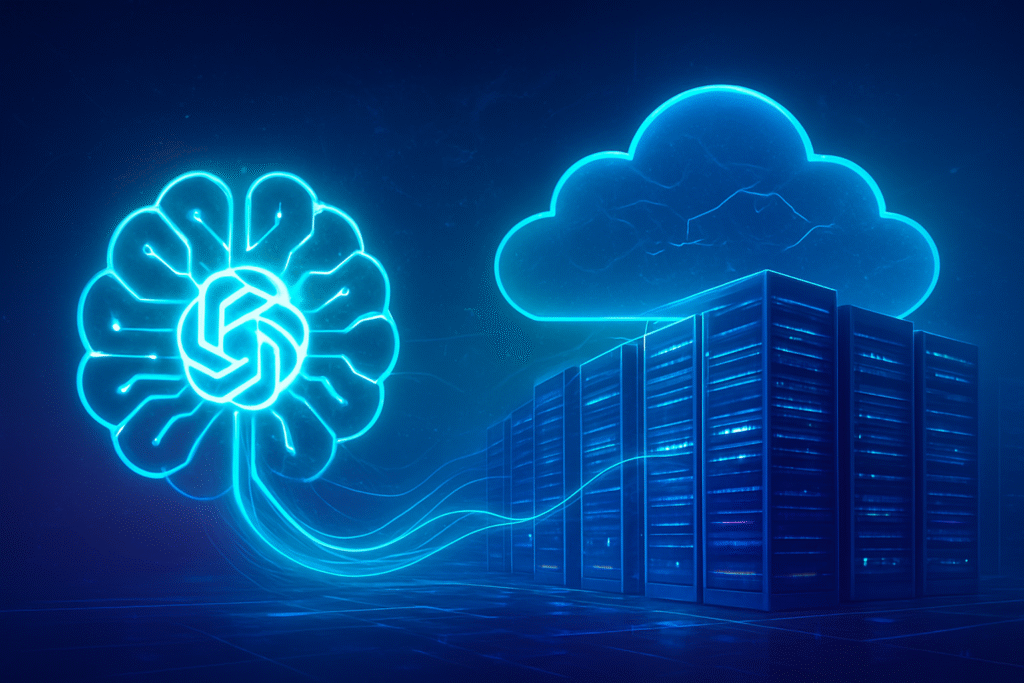
In a monumental announcement that sent ripples across the technology landscape today, November 3, 2025, OpenAI revealed a strategic multi-year partnership with Amazon Web Services (AWS) (NASDAQ: AMZN) valued at an staggering $38 billion. This landmark agreement signifies a pivotal shift in OpenAI's cloud computing strategy, marking its first major collaboration with the world's leading cloud infrastructure provider and immediately reshaping the dynamics of the artificial intelligence and cloud computing sectors. The deal underscores the insatiable demand for computational power driving the AI revolution and highlights the increasingly intricate web of alliances forming among tech giants.
The partnership is poised to provide OpenAI with unprecedented access to massive computing capacity, a critical necessity for training its next-generation AI models and scaling its existing advanced generative AI services, including the ubiquitous ChatGPT. For Amazon (NASDAQ: AMZN), this represents a significant victory, solidifying AWS's position as a cornerstone infrastructure provider for one of the most innovative and influential companies in the rapidly expanding AI industry. This alliance is not just about compute; it's a strategic maneuver that could redefine the competitive landscape for years to come.
A Deep Dive into the Compute Colossus: Technical Specifications and Strategic Diversification
The seven-year agreement between OpenAI and Amazon Web Services is meticulously designed to fuel OpenAI's ambitious AI development roadmap. At its core, the deal grants OpenAI immediate and expanding access to AWS's cutting-edge infrastructure, specifically leveraging hundreds of thousands of NVIDIA (NASDAQ: NVDA) graphics processing units (GPUs). This includes the highly anticipated GB200s and GB300s, with a significant portion of this capacity expected to be deployed by the end of 2026 and further expansion options extending into 2027 and beyond. The primary deployment will be within the United States, utilizing AWS's Amazon EC2 UltraServers, which are engineered for high-performance AI processing, ensuring maximum efficiency and low-latency across interconnected systems.
This partnership is a direct response to OpenAI's escalating need for "massive, reliable compute" to advance its "agentic workloads" and train increasingly complex AI models. The technical specifications point to a future where OpenAI can iterate on its models at an unprecedented scale, pushing the boundaries of what generative AI can achieve. This approach differs significantly from previous strategies where a single cloud provider might have dominated. By integrating AWS into its compute ecosystem, OpenAI gains access to a robust, scalable, and globally distributed infrastructure, which is crucial for maintaining its leadership in the fast-evolving AI domain.
Initial reactions from the AI research community and industry experts have been largely positive, albeit with some caveats regarding the sheer scale of investment. Many see this as a pragmatic move by OpenAI to diversify its cloud dependencies. This deal follows a renegotiation of OpenAI's long-standing partnership with Microsoft (NASDAQ: MSFT), which previously held a "right of first refusal" for exclusive cloud provisioning. While OpenAI has committed an additional $250 billion to Microsoft Azure services, and reportedly engaged with Oracle (NYSE: ORCL) for a $300 billion deal and Google (NASDAQ: GOOGL) for further discussions, the AWS agreement firmly establishes OpenAI's new multi-cloud strategy. This diversification not only enhances operational resilience but also fosters a more competitive environment among cloud providers, potentially driving further innovation in AI infrastructure. However, the cumulative infrastructure spending commitments, reportedly reaching over $610 billion for OpenAI across various providers and a staggering $1.4 trillion overall, have sparked discussions among market watchers about a potential "bubble" in AI spending and infrastructure investment.
Reshaping the AI Landscape: Competitive Implications and Market Dynamics
The $38 billion pact between OpenAI and Amazon Web Services carries profound implications for AI companies, tech giants, and burgeoning startups alike, fundamentally reshaping the competitive landscape. OpenAI stands to be a primary beneficiary, gaining not only a substantial increase in compute power but also a diversified and resilient infrastructure backbone. This move significantly bolsters its ability to innovate rapidly, train more sophisticated models, and scale its services globally, further cementing its position as a frontrunner in generative AI. The enhanced capabilities are expected to translate into more powerful and reliable AI products, benefiting its enterprise clients and end-users of platforms like ChatGPT.
For Amazon (NASDAQ: AMZN) and its AWS division, this deal is a monumental win. It unequivocally positions AWS as a premier destination for hyperscale AI workloads, directly challenging rivals like Microsoft Azure and Google Cloud. The agreement serves as a powerful validation of AWS's infrastructure capabilities, security, and expertise in handling the most demanding AI requirements. This strategic advantage could attract other major AI players and enterprise clients seeking robust, scalable, and reliable cloud solutions for their AI initiatives. Amazon's stock saw a notable uptick following the announcement, reflecting investor confidence in this significant market capture.
The competitive implications for major AI labs and tech companies are substantial. Microsoft (NASDAQ: MSFT), while still a major partner for OpenAI, now faces increased competition from AWS in servicing OpenAI's compute needs. This multi-cloud approach by OpenAI could encourage other AI developers to diversify their cloud providers, leading to a more fragmented and competitive cloud market for AI infrastructure. Startups, while not directly benefiting from the $38 billion deal, will observe this trend closely. The increased availability of advanced AI infrastructure, driven by hyperscalers competing for top-tier clients, could indirectly lead to more accessible and affordable compute resources for smaller players in the long run. However, the immense spending by AI leaders also raises the barrier to entry, potentially making it harder for undercapitalized startups to compete at the frontier of AI development. This deal could disrupt existing product roadmaps, forcing cloud providers to accelerate their AI-specific offerings and services to remain competitive.
Wider Significance: AI Trends, Impacts, and Future Concerns
This colossal $38 billion deal between OpenAI and Amazon Web Services fits squarely into the broader AI landscape, highlighting several critical trends. Firstly, it underscores the relentless pursuit of computational power as the primary fuel for advancing artificial general intelligence (AGI). The sheer scale of the investment reflects the industry's belief that more powerful models require exponentially greater compute resources. This partnership also exemplifies the growing trend of strategic alliances among tech giants, where traditional competitors find common ground in servicing the burgeoning AI market. It's a testament to the fact that no single company, not even one as dominant as OpenAI, can unilaterally build and maintain the entire infrastructure required for frontier AI development.
The impacts of this deal are far-reaching. For the AI industry, it means an accelerated pace of innovation, as OpenAI gains the necessary resources to push the boundaries of model size, complexity, and capability. This could lead to breakthroughs in areas like reasoning, multi-modal AI, and agentic systems. For cloud computing, it solidifies AWS's leadership in the high-stakes AI infrastructure race and will likely spur further investment and innovation in specialized hardware and software for AI workloads across all major cloud providers. However, potential concerns also emerge. The concentration of immense compute power in the hands of a few leading AI labs, even if distributed across multiple cloud providers, raises questions about ethical AI development, accessibility, and the potential for a "compute divide" that widens the gap between well-funded entities and smaller research groups. The massive capital expenditure also fuels concerns about the sustainability of the current AI boom and whether the returns will justify the astronomical investments.
Comparing this to previous AI milestones, this deal isn't a singular algorithmic breakthrough but rather an infrastructure milestone that enables future breakthroughs. It echoes the early days of the internet, where massive investments in data centers and network infrastructure laid the groundwork for the digital revolution. While not as immediately tangible as AlphaGo beating a Go champion or the release of GPT-3, this partnership is a foundational event, providing the bedrock upon which the next generation of AI innovations will be built. It signifies a maturation of the AI industry, moving beyond purely research-focused endeavors to large-scale industrialization and deployment.
The Road Ahead: Expected Developments and Emerging Challenges
Looking ahead, the strategic alliance between OpenAI and Amazon (NASDAQ: AMZN) is expected to catalyze a cascade of near-term and long-term developments across the AI ecosystem. In the near term, we can anticipate a significant acceleration in the development and deployment of OpenAI's "agentic workloads" – AI systems capable of autonomous decision-making and task execution. This could manifest as more sophisticated AI assistants, enhanced automation tools, and more capable generative models that understand and respond to complex prompts with greater nuance. The increased compute capacity will also likely enable OpenAI to train larger and more multimodal models, integrating text, image, audio, and video more seamlessly.
On the horizon, potential applications and use cases are vast. Expect to see advancements in personalized AI, scientific discovery, and complex problem-solving. For instance, more powerful AI could dramatically accelerate drug discovery, material science, or climate modeling. The partnership could also lead to more robust and reliable AI for critical infrastructure, from autonomous transportation to advanced cybersecurity systems. The enhanced scalability offered by AWS will also facilitate the global deployment of OpenAI's services, making advanced AI more accessible to businesses and individuals worldwide.
However, several challenges need to be addressed. The sheer energy consumption of such massive AI infrastructure is a growing concern, necessitating innovations in sustainable computing and energy efficiency. Ethical considerations around AI safety, bias, and accountability will also become even more critical as AI systems grow in capability and autonomy. Furthermore, managing the operational complexities of a multi-cloud strategy across different providers will require sophisticated orchestration and robust security protocols. Experts predict that this deal will intensify the race among cloud providers to offer even more specialized and optimized AI infrastructure, potentially leading to a new era of "AI-optimized" data centers and hardware. We might also see a consolidation of AI model training onto a few dominant cloud platforms, raising questions about vendor lock-in and open-source alternatives.
A New Epoch for AI: Wrapping Up a Transformative Alliance
The $38 billion partnership between OpenAI and Amazon Web Services represents a truly transformative moment in the history of artificial intelligence. It is a powerful testament to the escalating demand for computational resources necessary to fuel the next wave of AI innovation. The deal's key takeaways include OpenAI's strategic pivot to a multi-cloud approach, significantly enhancing its operational resilience and compute capacity, and AWS's reinforced position as a dominant force in providing hyperscale AI infrastructure. This alliance not only benefits the two companies directly but also signals a broader industry trend towards massive infrastructure investments to support frontier AI development.
This development's significance in AI history cannot be overstated. While not a direct algorithmic breakthrough, it is a foundational infrastructure agreement that will enable countless future breakthroughs. It underscores that the future of AI is deeply intertwined with the scalability, reliability, and accessibility of cloud computing. This partnership effectively lays down a critical piece of the global infrastructure needed for the realization of more advanced and pervasive AI systems. It is a strategic move that acknowledges the distributed nature of modern technological advancement, where even leading innovators rely on a robust ecosystem of partners.
Looking ahead, the long-term impact will likely include an acceleration in AI capabilities across various sectors, intensified competition among cloud providers for AI workloads, and continued debates around the economic and ethical implications of such vast AI investments. What to watch for in the coming weeks and months includes further details on the specific deployments of NVIDIA (NASDAQ: NVDA) GPUs, the rollout of new OpenAI models and features leveraging this enhanced compute, and how competitors like Microsoft (NASDAQ: MSFT) and Google (NASDAQ: GOOGL) respond with their own strategic partnerships or infrastructure announcements. This deal is not merely a transaction; it is a harbinger of a new epoch in AI development, characterized by unprecedented scale and strategic collaboration.
This content is intended for informational purposes only and represents analysis of current AI developments.
TokenRing AI delivers enterprise-grade solutions for multi-agent AI workflow orchestration, AI-powered development tools, and seamless remote collaboration platforms.
For more information, visit https://www.tokenring.ai/.






